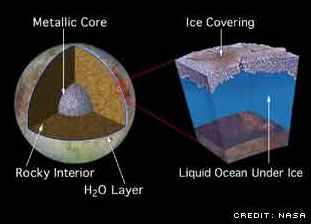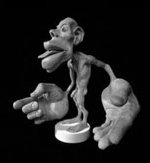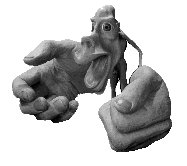"When we think of extraterrestrial life, we imagine terrestrial conditions on an exoplanet [*]. Wouldn't it be possible for an intelligent life form, advanced technologically, to exist under quite different conditions that on our good old Earth? And what conditions could these be?"
"Why should these alleged extraterrestrial visitors be so similar to us? Why not giant slugs, beings with tens of tentacles, winged beings?"
Most of the constraints which constitute clear stoppers to the development of a technology by a form of life of some planet are rather obvious for physical reasons.
Advanced technology cannot appear all made up in one blow, it is worked out by a continuation of improvements in time. The base of the development of a technology is the possibility of "picking up" objects and materials and of handling them, and the possibility to control fire, the only simple and nondependent on a pre-existing technology to come to grip with metallurgy, from which a continuation of technological developments can start.
The dolphin, land mammal with a brain not very different to the human brain, who evolved "back" to water, cannot, in this medium, start to use fire for metallurgy. For metallurgy, the form of life must thrive in atmospheric medium and not in aqueous medium that does not allow for fire.

|
Above: Europa, one of the Jupiter satellites. Planetologists strongly suspect that the cracks of the ice on the surface indicate the presence of a liquid water ocean below. The cracks are caused by the tidal deformations die to the proximity of the giant planet Jupiter, and show brownish material spouts indicating waters rich in chemical compounds that could nourish life forms in such an ocean. But in water, such life forms cannot control fire and thus cannot end up building tools, machines, or spaceships.
A tree, a form of life thriving in our atmospheric medium, cannot control fire, on the one hand because it is not mobile, thus cannot prospect for minerals, on the other hand because it does not have the possibility of manipulate objects.
Ants thrive in our atmospheric medium and are capable of gripping stuff, but their small size results in the inability to approach any source of fire without melting.

|
While the first hominids evolved into beings creative of technology within 5 million years, ants exist on the Earth for more than 600 million years, in a practically unchanged form, but could not develop any technology: they are too tiny to develop a complex brain, too tiny to approach fire without melting.
A form of life will be favored to develop a technology inasmuch it benefits of:
Other characteristics are assets in a general manner, but also in terms of advantages for the development of a technology:
Among the easy to describe advantages, those of gripping organs make it possible to realize the numbers of advantages of the humanoid form on other forms of which our own planet provides us a vast and very diversified collection.
With only a mouth, or only one hand, it is not easy to hold something and to work it at the same time.
With fingers that would not be articulated, it is not easy to handle objects well.
With only two fingers, it is much more difficult to handle objects than with five.
 Sensory Homunculus. |
 Motor Homunculus. |
Above: The Homunculus: representations of human being in which the size proportions of body areas are not real, but in proportion of the volume that the management of these areas occupies in the brain.
The Sensory Homunculus and the Motor Homunculus show how important the hands and the fingers are to the human being, while feet "function" almost "automatically" and are not used for complex material handling.
With nails, hard nails, it is easier to carry out certain handling than without nails. But with an entirely nailed finger, there is no real possibility of an elaborate sense of touch making it possible to feel textures, temperatures, hardness or flexibility of handled objects and materials. Combination of significant fleshy parts with nails at the end of the fingers brings many advantages.
The question "which forms can life take on a planet" is not the question "which kinds of forms of lifes on which kinds of planets can develop a technology."
This was by no means some discussion about which forms life can take. Our own planet shows a a huge diversity of life forms. All life forms on our planet are not humanoid like men and apes. We have animal and plants, not mentioning fungi [**] which are neither animal nor vegetal, we have unicellular and multicellular life forms, not mentioning symbiotic forms of life such as lichens, and not mentioning viruses whose nature causes controversies on the limits between the alive one and the non-alive.
The question of "which kinds of life forms can develop a technology" not being the question of "which diversity of living form can there be", the answer to these two questions is thus obviously not the same.
The question of intelligence of life forms is neither the same question. Intelligence in dolphins, for example, is an interesting discussion topic; but no matter the outcome, dolphins do not have the right morphology for developing a technology and are not in a medium suited to control of fire, construction of computer or spaceships.
Sometimes, the notion of a so-called telekinesis as substitute to actual gripping to handle and manufacture objects is put forth.
But no human technological realization ever resulted from telekinesis. From the wheel to the television set to the rocket, computers, reaping-machines, fountain pens, nothing ever came from any such supposed "mind-over-matter power".
There is no reason to call upon an alleged telekinesis as substitute for actual gripping in extraterrestrial technologies: until proven otherwise, there are no reliable sighting reports in which it is shown that alien technology would result from manufacture by telekinesis. On the contrary, it is quite obvious that the UFO occupants are almost always described as having arms, hands, i.e. means of gripping morphologically similar to ours. In fact, almost all the described UFO occupants in the cases having a minimum of reliability, and even the others, are humanoids.
It is obvious that if alien UFO occupants without members, hands, fingers, using telekinesis for lack of such organs, had developed a technology that allowed them to visit us, they should be reported, but it is simply not so.
In addition, the concept that objects can be handled by virtue of thought to build a technology has no base. Thought is no way some kind of "force" making it possible to move or alter materials directly. There is a number of allegations of the opposite, of course, but valid demonstration is not at hand, so there is no reason to believe that such allegations are true.
On the contrary, the fact that gripping organs such as hands and fingers make it possible to handle and manufacture objects is out of doubt, as everyone can check any time for his own satisfaction.

|
Above: Our galaxy, the Milky Way, as it appears "seen from above", contains at least 200 billion stars.

|
Above Neither an extraterrestrial monster who came to land on our planet, nor an octopus: Anthurus, a mushroom that can be found in various countries such as Australia and France.